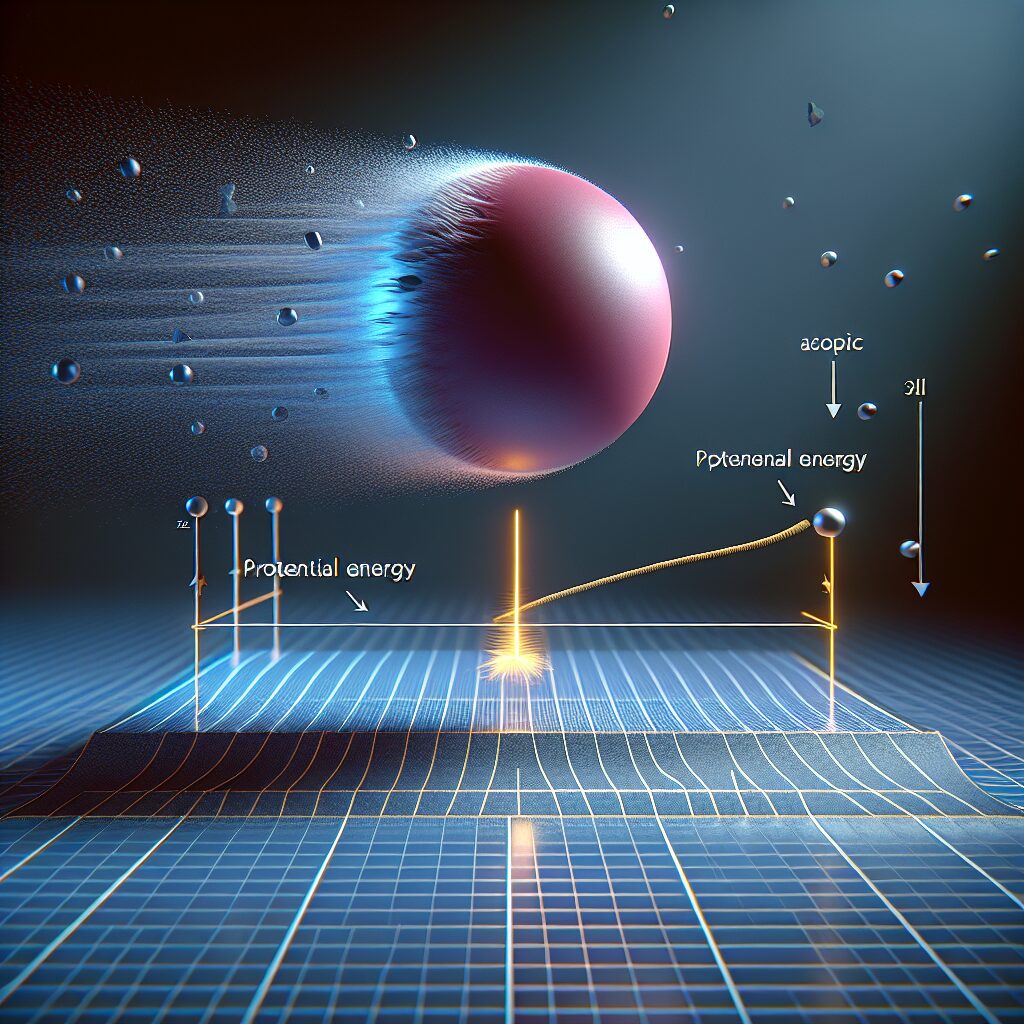Rubber and Ball Bounce: The Science of Elevation
Rubber and ball bounce may seem like simple concepts, but the science behind them is fascinating. Before delving into the intricacies of how rubber and balls interact, let’s first define these terms. Rubber, a highly elastic material, is commonly used in the production of balls for various sports and recreational activities. Its ability to deform under pressure and quickly regain its original shape makes it ideal for bouncing. When a ball is dropped or thrown onto a surface, its interaction with the rubber material determines the bounce height and trajectory.
Understanding the principles behind rubber and ball bounce opens up a world of possibilities, both in terms of gameplay and product development. The physical properties of rubber have a significant impact on the bounce of a ball, including its elasticity, stiffness, and compression. These properties determine how much energy is transferred during the impact, as well as the rate at which the ball rebounds. By analyzing these factors, researchers and engineers can optimize the design of balls for specific activities, such as basketball, tennis, or even bouncing toys for children.
In the upcoming sections, we will explore the key takeaways related to the science of rubber and ball bounce. We will delve into the factors that affect the bounce height, such as the composition of the ball and the surface it interacts with. Additionally, we will discuss the implications of these findings in various industries, from sports equipment manufacturing to physics education. Join us as we uncover the secrets behind the mesmerizing physics of rubber and ball bounce.
Key Takeaways
1. The height to which a ball bounces depends on the percentage of its initial potential energy that is converted into elastic potential energy when it hits the ground. This conversion is dictated by the elasticity of the ball and the surface it bounces on.
2. The coefficient of restitution (COR), a measure of the elasticity of a ball, determines how high a ball will bounce. A lower COR means less energy is retained and transferred during a bounce, resulting in a lower bounce height.
3. The surface on which the ball bounces also affects its bounce height. A harder surface with less give, such as concrete, results in a higher bounce due to its ability to better transmit energy back to the ball.
4. When the ball reaches its maximum displacement on the bounce, known as the zero-rebound point, it has the maximum stored elastic potential energy. However, due to energy losses from friction and air resistance, the ball will never reach the same height as its initial drop.
5. Rubber balls generally exhibit higher COR values compared to other materials, making them more suitable for activities requiring a higher bounce, such as ball sports or games. The choice of ball material plays a significant role in optimizing performance and ensuring an enjoyable experience.
Understanding Rubber and Ball Bounce: The Science of Elevation
1. Elasticity and Energy
When it comes to the science of rubber and ball bounce, one key factor that plays a significant role is elasticity. Rubber is known for its elastic properties, which allow it to deform temporarily under impact and then regain its original shape. This elasticity is crucial in determining the height a ball can bounce. When a ball hits a surface, such as the ground, the rubber deforms and stores energy. As the rubber rebounds, this stored energy is quickly released, resulting in the ball bouncing back up into the air.
2. Material Composition
Another important aspect in understanding the science of rubber and ball bounce is the composition of the materials involved. Rubber balls are commonly made of materials like vulcanized rubber or synthetic rubber compounds. These materials are selected for their ability to provide the desired bounce characteristics. The composition determines factors such as the ball’s elasticity, durability, and rebound efficiency. Different rubber compositions can lead to variations in bounce height and overall performance.
3. Ball Design
The design of the ball itself also influences its bounce. Factors such as size, shape, and surface texture can impact the height achieved during a bounce. For example, a ball with a smooth surface may bounce higher compared to a ball with a rough surface that creates more friction upon impact. Similarly, the size and shape of the ball can affect how it interacts with the surface, leading to variations in bounce height and trajectory.
4. Impact Force and Angle
When a ball strikes a surface, the force and angle of impact play a significant role in determining the bounce height. The greater the force with which the ball hits the surface, the higher it will bounce. Similarly, the angle at which the ball contacts the surface can affect the rebound. Different angles can result in varying levels of impact, leading to diverse bounce heights. Understanding the relationship between impact force, angle, and the resulting bounce can help predict and control elevation.
5. Surface Characteristics
The characteristics of the surface on which the ball bounces also contribute to the overall elevation achieved. Soft surfaces, such as grass or foam, tend to absorb more energy upon impact, reducing the bounce height. Conversely, harder surfaces like concrete or wood provide less absorption, resulting in higher bounces. Surface smoothness and levelness also affect the bounce. Irregular surfaces or those with obstacles can disrupt the natural rebound and lead to unpredictable bounces.
6. Environmental Factors
Various environmental factors can impact the science of rubber and ball bounce for elevation. Temperature, for instance, affects the properties of rubber. Cold temperatures can reduce the elasticity of rubber, leading to lower bounce heights. Similarly, air pressure can affect the ball’s internal pressure, which impacts its bounce. Additionally, altitude can influence the gravitational force acting on the ball, affecting its overall elevation.
Tips for Achieving Optimal Rubber and Ball Bounce Elevation
- Choose a rubber ball with a composition specifically designed for high bounce.
- Ensure the ball’s surface is clean and free from dirt or debris, as it can affect the bounce.
- Select a surface with appropriate characteristics for the desired bounce height.
- Optimize the impact force and angle by adjusting throwing or hitting techniques.
- Consider environmental factors like temperature and air pressure when aiming for optimal bounce elevation.
Frequently Asked Questions
1. How does rubber affect the bounce of a ball?
Rubber affects the bounce of a ball due to its elastic properties. When a ball made of rubber hits a surface, the rubber compresses to absorb the impact, storing energy in the process. This stored energy is then released, causing the rubber to spring back and propel the ball upwards, resulting in its bounce.
2. Why do some balls bounce higher than others?
The bounce height of a ball is influenced by various factors such as the type and quality of rubber used, the amount of air inside the ball, and the surface on which it bounces. Balls made with higher-quality rubber tend to have better elasticity, leading to higher bounces. Additionally, balls with more air pressure or inflated to a higher level tend to bounce higher.
3. Can the temperature affect the bounce of a ball?
Yes, temperature can affect the bounce of a ball. When exposed to cold temperatures, the rubber in the ball becomes stiffer and less elastic, resulting in a lower bounce. On the other hand, high temperatures can make the rubber softer and more elastic, leading to a higher bounce.
4. What role does the surface play in ball bounce?
The surface on which a ball bounces plays a crucial role in its bounce height. Hard and rigid surfaces, such as concrete or hardwood floors, tend to provide a higher bounce as they do not absorb much of the ball’s energy. Softer surfaces, like grass or carpet, absorb more energy, resulting in a lower bounce.
5. How do different ball materials affect bounce?
Different ball materials can significantly impact the bounce. Rubber balls, due to their elastic properties, generally have better bounce compared to balls made of materials like plastic. The specific formulation and quality of the rubber used in the ball also influence its bounce characteristics.
6. What is the relationship between ball size and bounce?
Generally, larger balls tend to have a higher bounce compared to smaller ones. This is mainly because larger balls have a larger surface area and a higher volume of air trapped inside, allowing for more energy transfer during impact and resulting in a higher bounce.
7. Can the weight of a ball affect its bounce?
Yes, the weight of a ball can affect its bounce to some extent. Heavier balls tend to have a slightly lower bounce compared to lighter ones. However, other factors such as the ball’s elasticity and the surface on which it bounces have a more significant impact on the bounce.
8. How does air pressure influence ball bounce?
Air pressure has a direct impact on ball bounce. Higher air pressure inside the ball leads to a firmer ball, allowing it to bounce higher. Conversely, lower air pressure makes the ball softer and reduces its bounce height.
9. Can the altitude at which a ball is used affect its bounce?
Yes, the altitude at which a ball is used can affect its bounce. At higher altitudes, where air pressure is lower, balls tend to bounce higher due to the decreased resistance from the surrounding air. Conversely, at lower altitudes, the higher air pressure can slightly reduce the bounce height.
10. How is the concept of ball bounce utilized in sports and engineering?
The understanding of ball bounce is critical in various sports and engineering applications. In sports such as basketball or tennis, players utilize the bounce to control the ball’s trajectory and accurately aim their shots. In engineering, knowledge of ball bounce is used in designing shock-absorbing materials, creating efficient tires, and developing technologies such as airbags.
Final Thoughts: The Fascinating Science of Ball Bounce
The study of rubber and ball bounce provides captivating insights into the physics behind this everyday phenomenon. Understanding the factors that affect bounce height, such as rubber elasticity, air pressure, temperature, and surface properties, allows us to optimize ball performance for sports and engineering applications.
Whether it’s the thrill of a basketball bouncing off the court or the precision of a golf ball on the green, the science of ball bounce is a fascinating area of research and innovation. Exploring the intricacies of rubber and ball interaction not only deepens our understanding of physics but also contributes to advancements in various fields that rely on the principles of elevation and energy transfer.




